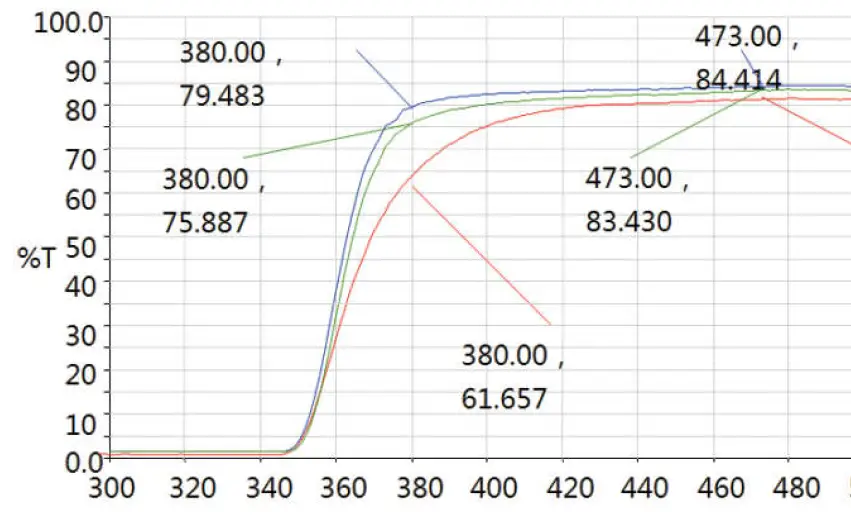Gray Tracking Resistance Potassium Titanyl Phosphate (GTR-KTP) crystals are advanced nonlinear optical materials engineered to overcome the limitations of conventional KTP crystals, particularly their susceptibility to gray tracking. This phenomenon leads to increased IR absorption, reducing the efficiency and lifespan of the crystal in high-power laser systems. GTR-KTP crystals, developed with innovative manufacturing processes, exhibit significantly higher resistance to gray tracking and lower absorption in the UV and visible regions, making them suitable for a wide range of applications such as frequency doubling, parametric oscillation, and laser amplification.
GTR-KTP crystals maintain the desirable properties of conventional KTP, such as a high nonlinear optical coefficient, wide angular and temperature bandwidths, and low walk-off angle. Additionally, these crystals boast a higher laser damage threshold, making them reliable for high-energy and high-repetition laser applications. These unique properties, combined with high durability and chemical stability, position GTR-KTP crystals as a superior choice for industrial, scientific, and medical laser systems.
GTR-KTP crystals are widely utilized in applications that demand high-performance nonlinear optical materials with improved durability and resistance to gray tracking. Some notable applications include:
GTR-KTP’s unique properties ensure higher conversion efficiencies, longer crystal lifespans, and reduced maintenance, making them a preferred choice for demanding applications.
| Property | Specification |
|---|---|
| Crystal Structure | Orthorhombic, Space group Pna2₁ |
| Lattice Parameters | a = 6.404 Å, b = 10.616 Å, c = 12.814 Å |
| Density | 3.01 g/cm³ |
| Melting Point | Approximately 1172 °C |
| Thermal Expansion Coefficients | a₁ = 11 × 10⁻⁶/°C, a₂ = 9 × 10⁻⁶/°C, a₃ = 0.6 × 10⁻⁶/°C |
| Thermal Conductivity | 13 W/m·K |
| Chemical Stability | Non-hygroscopic, resistant to environmental degradation |
| Property | Specification |
|---|---|
| Transparency Range | 350–4500 nm |
| SHG Phase Matching Range | 497–1800 nm (Type II) |
| Nonlinear Coefficients (pm/V) | d₃₁ = 6.5, d₃₂ = 5.5, d₃₃ = 13.7 |
| Damage Threshold | >1.8 GW/cm² at 1064 nm (10 ns, 1 Hz) |
| Walk-off Angle | 0.55° at 1064 nm |
| Absorption Coefficients | <0.1% at 1064 nm, <1% at 532 nm |
| Refractive Index (n) | nₓ = 1.807, nᵧ = 1.841, n𝓏 = 1.899 |
| Thermal-Optic Coefficients (°C⁻¹) | dnₓ/dT = 1.1 × 10⁻⁵, dnᵧ/dT = 1.3 × 10⁻⁵, dn𝓏/dT = 1.6 × 10⁻⁵ |
| Parameter | Specification |
|---|---|
| Dimension Tolerance | ±0.1 mm × ±0.1 mm × ±0.1 mm |
| Angle Tolerance | Δθ < 0.25°, Δφ < 0.25° |
| Surface Quality | 10/5 to MIL-PRF-13830B |
| Flatness | λ/8 @ 633 nm |
| Parallelism | <20 arc seconds |
| Perpendicularity | <15 arc minutes |
| Clear Aperture | >90% of the diameter |
| Damage Threshold | >1 GW/cm² @ 1064 nm, >0.3 GW/cm² @ 532 nm |
| Warranty | One year under proper use |

| Base Material | AR Coating | Reflectance |
|---|---|---|
| GTR-KTP | Dual Band AR (1064/532 nm) | R < 0.2% @ 1064 nm, R < 0.5% @ 532 nm |
| HR Coating (1064 nm) | R > 99.8% @ 1064 nm | |
| Broad Band AR (OPO Range) | R < 2% @ 1064–266 nm |
| Face Dimensions (mm) | Length (mm) | Coatings | Application | Price (USD) |
|---|---|---|---|---|
| 3 × 3 | 5 | AR@1064/532 nm | SHG of Nd:YAG lasers | 350 |
| 5 × 5 | 10 | HR@1064 nm | High-power laser systems | 500 |
| 7 × 7 | 15 | BBAR (OPO range) | OPO and parametric gain | 750 |
| Custom | Custom | Upon Request | Custom Applications | TBD |